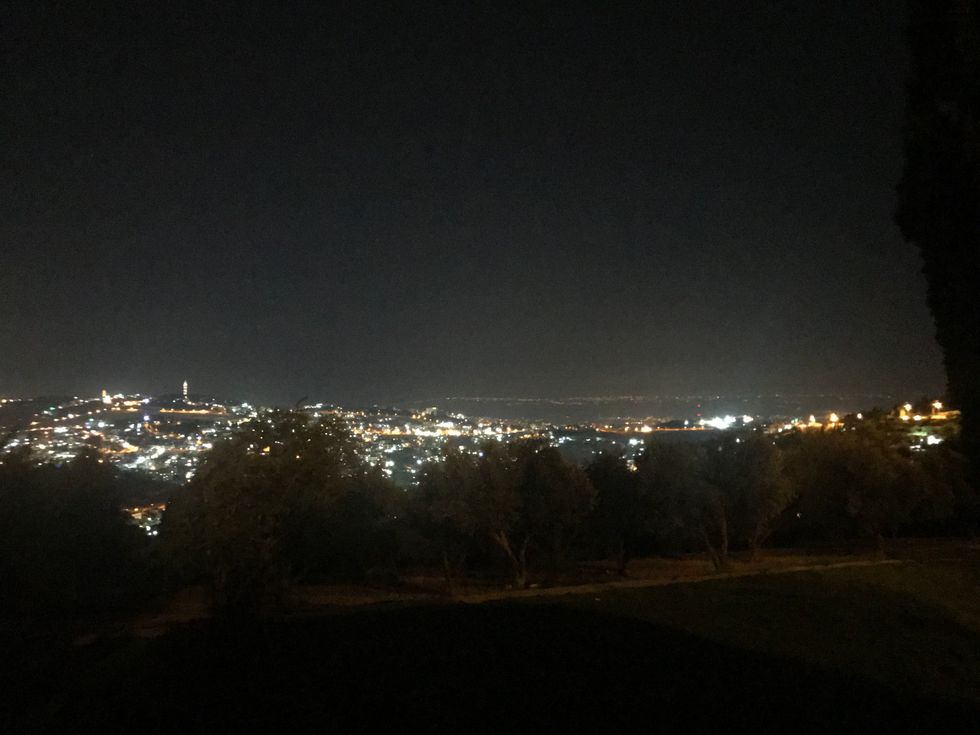Our time in Jerusalem felt like forever, yet it also went by so quickly; I promised myself that I would be back one day. On our last morning, we headed back to the Old City one more time. We were finally going to visit the Al-Aqsa Mosque/Dome of the Rock/Temple Mount.
In Islam, the Al-Aqsa Mosque one of three Sacred Mosques; it is the third holiest site in the world for Muslims. The Dome of the Rock (which is the structure with the beautiful golden dome) is where it's believed that Muhammad ascended to heaven and talked to Allah; there, he was given the second pillar of Islam, which manifests in the Muslim prayer that happens five times per day. Today, Jews are not allowed to pray at the Temple Mount, and only Muslims are allowed in the Dome of the Rock and the Al-Aqsa Mosque.
The Al-Aqsa Mosque translates to "the Farthest Mosque," and it's built on the Mount to face Mecca. It was built by the Umayyad Caliphs during their rule of Palestine, and today, the Mosque is the oldest extant Islamic building. Both the Mosque and the Dome are incredibly beautiful piece of architectures, and I really appreciated the reverence with which guests regarded them. Despite the high winds and biting cold air, there was a quiet sense of peace atop the Mount, standing in front of the Dome of the Rock. The colors were beautiful together, and I tried to decipher some of the calligraphy painted above the door frames.
A quick linguistic tangent: the Western Wall of the Temple Mount--the Jews' holy praying site--is sometimes referred to as the Wailing Wall. This is most commonly seen in other languages since many other countries thought Jews wept while they prayed at the wall, which was--and still is--a highly contested area. Some also argue that the "Western Wall" actually refers to something different than the "Wailing Wall." The Wailing Wall, in this sense, is a part of the Western Wall that is located in the Western Wall plaza; it's the 58 meter long site for praying. The Western Wall, on the other hand, refers to the entire length of the Western exterior wall of the Temple Mount, which is 485 meters long. This 400+ meter difference is controversial, and we can infer how one would use the language (either "Western Wall" or "Wailing Wall") to convey and argue for different things.
After our time at the Temple Mount and the Dome of the Rock, we headed to the Sheikh Jarrah neighborhood of Jerusalem where a peace organization is located. This organization is called Kids4Peace; we met with one of the Kids4Peace program directors, Carmiel Frutkoff. Kids4Peace is, according to their mission statement, "a global movement of youth and families, dedicated to ending conflict and inspiring hope in divided societies around the world." Here is a quote from their website:
"Kids4Peace operates international summer camps, leadership programs and a six-year, year-round program for more than 500 Palestinian, Israeli and North American youth.
Kids4Peace connects children and families across the lines that separate us. We are a grassroots, community-based organization, representing a wide diversity of religions, cultures, national identities, economic status and political point of view.
Kids4Peace nurtures long-term relationships among youth and families. We break down stereotypes and foster supportive, mature friendships rooted in spiritual values of equality and respect.
Kids4Peace facilitates honest dialogue about different historical narratives and current realities. We invite youth to listen to each other, to proudly share their own identities, and to hear painful and unfamiliar stories in a respectful environment.
Kids4Peace prepares youth to be public leaders. We equip them with skills and practices to resist violence, influence others toward peace, and work together for lasting change.
Kids4Peace spreads the message that 'Together, Peace is Possible.' We are ambassadors of hope who challenge cynical voices and commit to creating a better future.
We are trying to change the conversation—to bring new questions, and new answers to the struggle for peace, ones that are based in real relationships of trust and understanding."
Carmiel Frutkoff, along with his Palestinian K4P partner, Ismat Othman, explained what they do here and answered all the questions we had. In the next section, I will talk about what we heard!
- Language is a Powerful tool ›
- Separating Palestine and Israel would benefit them both ›
- Dear Students Flying Palestine's Flag: I'm Israeli Jewish & My ... ›
- Fighting Breaks Out Between Israel And Palestine ›
- Two-State Solution: Palestine & Israel ›
- Creating Peace in Israel & Palestine ›
- I Am Pro-Israel And Pro-Palestine ›




































